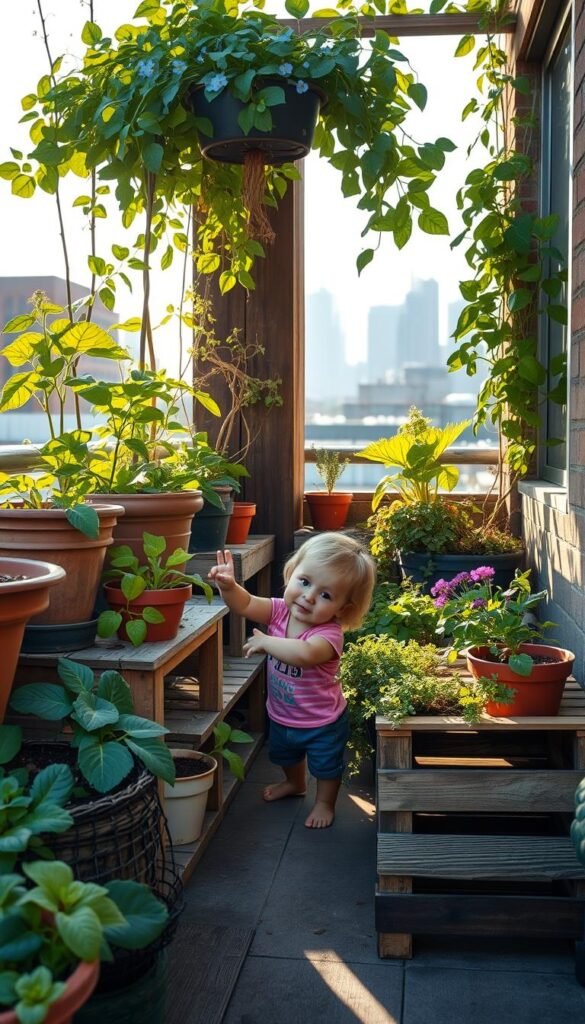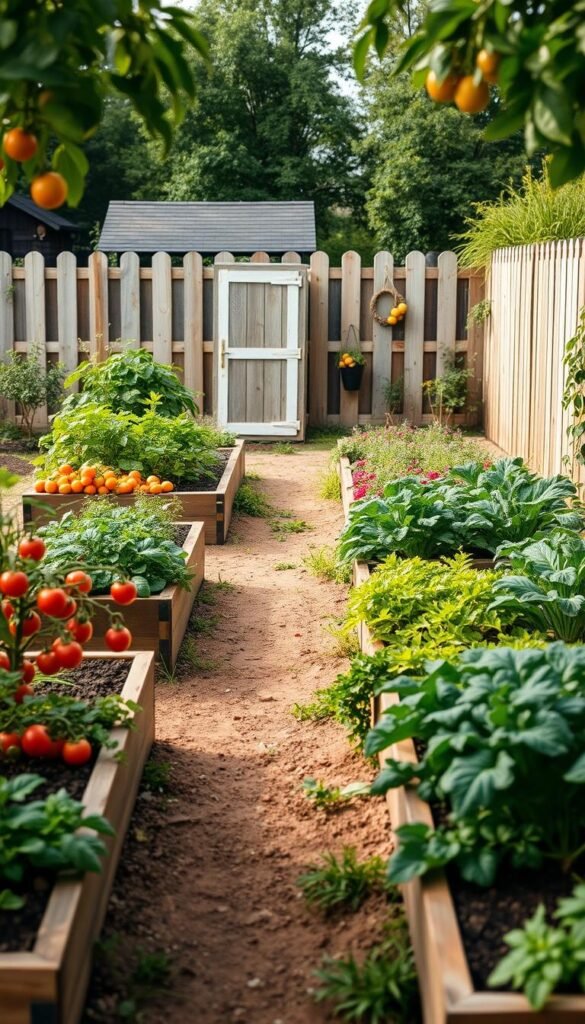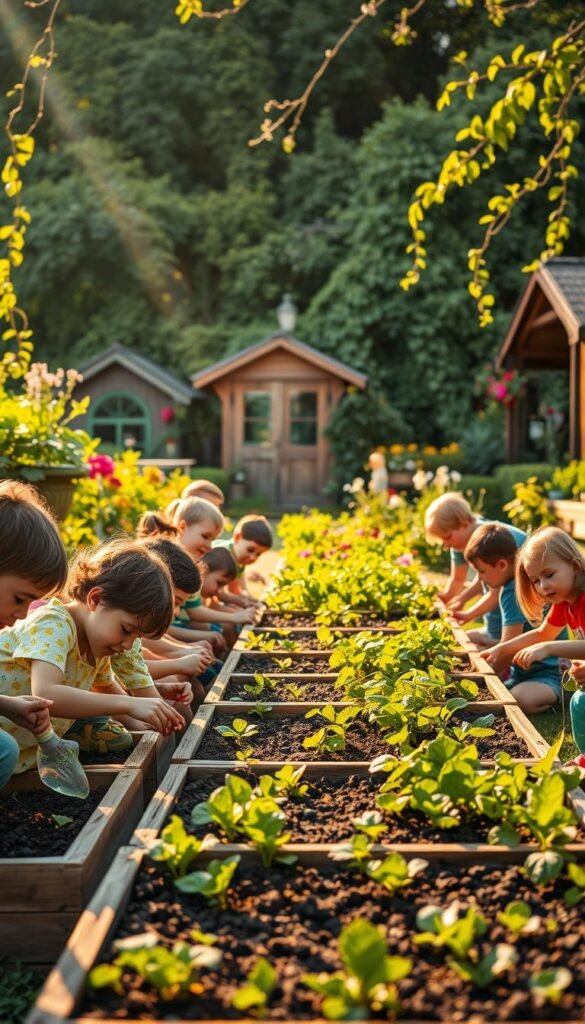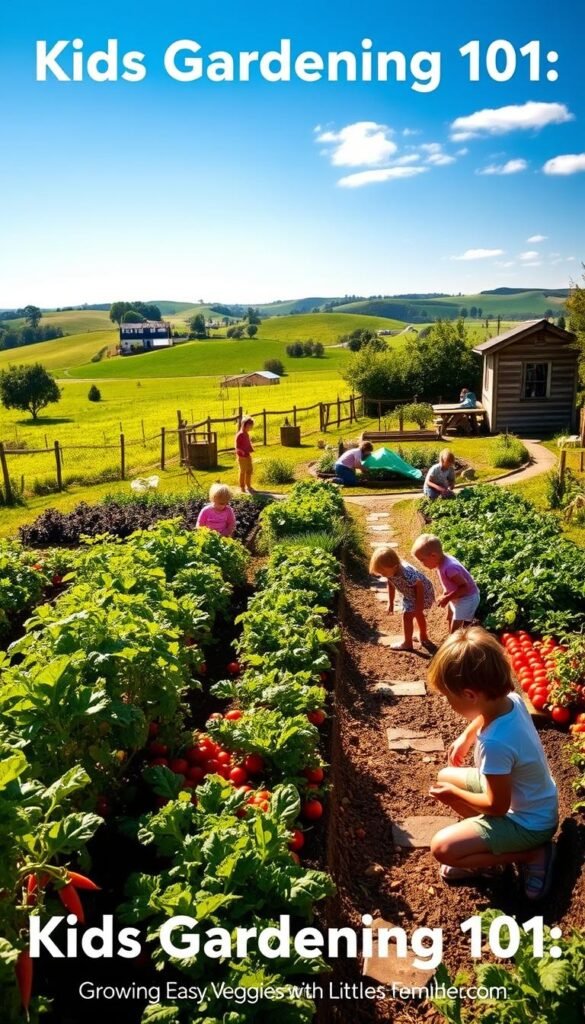Discover how dirt-covered hands and sun-warmed soil create unforgettable childhood memories. Outdoor projects that combine play with purpose help young minds connect with nature while developing essential skills. Studies show 76% of families who cultivate plants together notice improved healthy eating habits in their children.
This hands-on activity requires no prior expertise or sprawling spaces. A few containers or small garden beds can become living classrooms where curiosity blossoms. Fast-growing plants like cherry tomatoes and snap peas deliver quick wins, keeping enthusiasm high from planting to harvest.
You’ll learn how simple projects teach responsibility through daily care routines. Watering schedules and sunlight tracking become exciting challenges rather than chores. The pride glowing on a child’s face when serving homegrown salad greens makes every effort worthwhile.
Our guide simplifies the journey from seed selection to harvest celebration. We’ll reveal which crops thrive with minimal supervision and how themed plantings double as educational tools. Transform picky eaters into veggie enthusiasts through direct participation in food cultivation.
Why Gardening with Kids is an Exciting Adventure

Imagine transforming your backyard into a living classroom where every plant tells a story. Dirt under fingernails becomes a badge of honor, and sprouting seeds spark daily discoveries. This adventure blends science lessons with messy play, creating moments that stick better than glue-on glitter.
Discovering the Joy of Outdoor Learning
You’ll watch curiosity bloom as young explorers investigate worm tunnels and ladybug habitats. Research shows hands-on nature experiences improve focus and creativity more than screen time. Tracking plant growth becomes a real-life math lesson – no worksheets required!
Three unexpected benefits emerge:
- Natural patience builders as sprouts take weeks to appear
- Sensory development through textures like fuzzy leaves and crumbly soil
- Weather awareness from checking rain gauges and sun patterns
Building Confidence and Healthy Habits
That first homegrown carrot often becomes a child’s proudest achievement. “I grew this myself!” turns picky eaters into veggie ambassadors overnight. Simple routines like watering duty teach responsibility through small, achievable tasks.
You’ll notice changes beyond the garden bed:
- Improved coordination from handling tools and seeds
- Better sleep patterns after active outdoor time
- Family bonding during daily check-ins on plant progress
Setting Up Your Kid-Friendly Garden Space

Turn cramped corners into lush vegetable havens using smart space solutions. Urban dwellers can transform balconies, fire escapes, or sunny windows into thriving edible zones. Research confirms container gardens yield 30% more produce per square foot than traditional plots when optimized.
Choosing Containers and Utilizing Small Spaces
Select pots that match your plants’ needs – deep ones for carrot taproots, wide bowls for leafy greens. A 5-gallon bucket grows robust tomato plants, while hanging planters keep strawberries away from slugs. “Vertical space is your secret weapon,” says urban farmer Mia Rodriguez. Pair climbing beans with trellises to create living walls that fascinate young growers.
Drainage holes prevent soggy roots – drill extras in recycled containers. Use lightweight potting mix instead of dense garden soil. Rotate pots weekly so plants grow evenly toward sunlight.
Tips for Urban Gardening at Home
South-facing windows become salad factories with shallow herb boxes. Bright balconies host cherry tomatoes in self-watering planters – no daily attention needed. Try these space-smart combos:
- Lettuce + radishes in window boxes (harvest radishes first)
- Pole beans + marigolds in tall pots (natural pest control)
- Pepper plants + basil in half-barrels (flavor companions)
Track sunlight patterns before positioning containers. Most edibles need 6+ hours daily – use reflective surfaces to boost light in shady areas. Involve children in decorating pots with weatherproof markers for added personal stakes.
Step-by-Step Guide to Planting Your First Vegetable Garden

Watch tiny hands transform ordinary soil into magical landscapes. Our family’s experimental year with vegetable boxes taught us that success isn’t measured by harvest size, but by sparking wonder. Those first emerald sprouts poking through earth? Pure magic for young eyes.
Planning Your Garden Layout
Start by mapping sunlight patterns like treasure hunters. Choose spots getting 6+ hours of daily sun near water sources. Pro tip: Let children test soil texture – crumbly earth means good drainage, clumpy means needs compost.
| Plant Type | Spacing | Depth | Sun Needs |
|---|---|---|---|
| Leafy Greens | 6″ apart | 1/4″ | Partial shade |
| Root Vegetables | 3″ apart | 1/2″ | Full sun |
| Climbing Plants | 12″ apart | 1″ | Full sun |
Create visual guides using colored sticks or stones to mark planting zones. “Young minds grasp spatial concepts better with physical boundaries,” notes vegetable gardening for beginners expert Lauren Burke. Mix fast-growers like radishes with slower plants to maintain interest.
Turn soil preparation into a science experiment. Test drainage by timing how fast water disappears in different areas. Record results in weatherproof journals using crayons – perfect rainy-day activity.
Celebrate every sprout like it’s winning the botanical lottery. Our failed carrots became compost lessons, while triumphant cherry tomatoes sparked salad revolutions. Remember: messy hands mean engaged minds growing alongside plants.
Kids Gardening 101: Growing Easy Veggies with Little Helpers

Unearth a world of flavor and fun with plants that turn small efforts into big rewards. These five superstar crops deliver visible progress and tasty outcomes, keeping young growers hooked from seed to snack time.
Exploring Five Easy Vegetables to Grow
Green beans outshine other starters with their rapid growth and climbing antics. Little hands can train vines up homemade teepees while learning about vertical space. “They’re practically foolproof,” says urban gardener Luis Moreno. “Perfect for first-time growers.”
Carrots transform soil into a surprise package. Their hidden growth becomes a thrilling excavation project. Use loose, stone-free dirt in deep containers for straight roots. Harvest days feel like digging for orange gold!
Potatoes thrive in fabric bags or old buckets, making them space-smart options. Watch eyes widen as you dump containers to reveal hidden tubers. It’s like a edible archaeological dig with instant mashed potato potential.
Cherry tomatoes become living candy machines. These sun-lovers produce endless sweet bites perfect for tiny fingers. Choose bush varieties for patio pots or hanging baskets.
Peas offer quick gratification with their speedy growth. Children love plumping pods and shelling emerald gems. Install simple trellises for climbing varieties or pick compact types for window boxes.
Bonus Tips on Growing Berries
Strawberries and raspberries sweeten the deal with juicy rewards. Compact everbearing varieties fruit all season in hanging planters or stacked pots. Protect ripening berries with netting – watching birds becomes part of the adventure.
Create a tasting trail by mixing red and golden varieties. The burst of homegrown flavor often converts fruit skeptics. Remember: berries need acidic soil and consistent moisture for best results.
Engaging Your Kids in the Gardening Process

Transform your green space into an interactive discovery zone where every leaf holds clues. Mystery-solving becomes part of daily routines as young investigators track plant changes and insect visitors. Did you know 68% of children prefer hands-on exploration over textbook learning?
Fun Gardening Activities and Experiments
Watch curiosity sprout during potato eye investigations. Let children sketch sprout development in weatherproof notebooks while explaining how one spud becomes many. Bean pod inspections teach pattern recognition – smooth surfaces mean ready-to-harvest, bulging shapes signal plump treasures inside.
Create carrot roulette by marking greens with colored ribbons. Guess which hue hides the largest root before the big pull. Strawberry scouts will patrol plants daily, learning that red undersides mean sweet rewards. “Half our crop never reaches the kitchen,” laughs parent-gardener Marco Silva. “But their juice-stained smiles beat any dessert.”
Creative Ways to Celebrate Harvests
Host a “dirt-to-plate” party using homegrown ingredients. Young chefs can assemble personal pizzas with garden basil or mix rainbow salads. Carrot tops become paintbrushes for creating harvest artwork on recycled paper.
Track progress through photo journals comparing seedling stages to mature plants. End each growing season with a ceremonial seed saving – dried beans and flower heads stored for next year’s adventures. These rituals build anticipation while teaching life cycle awareness.
Troubleshooting Common Gardening Challenges
Every plant project brings puzzle pieces to solve together. When leaves get nibbled or storms surprise your sprouts, these moments become powerful teaching tools. Let’s explore practical fixes that turn setbacks into science lessons.
Weather Wisdom and Space Solutions
Sudden frost? Drape old bedsheets over tender plants at night – it’s like tucking them in with a cozy blanket. Heat waves call for shade cloth tents that turn into sundial experiments. Track temperature changes using painted rocks as nature’s thermometers (darker colors absorb more heat).
| Challenge | Protective Measure | Child-Friendly Benefit |
|---|---|---|
| Bird visitors | Colorful netting | Observe wildlife safely |
| Limited space | Stacked planters | Learn vertical math |
| Pest bugs | Marigold borders | Insect identification |
| Heavy rain | Rock drainage paths | Water flow experiments |
Transform pest patrol into a bug safari. Magnifying glasses reveal ladybug larvae devouring aphids – nature’s cleanup crew! Damaged leaves become art supplies for leaf-rubbing journals. “Our holey kale inspired butterfly wing drawings,” shares teacher-gardener Lila Chen.
When crops struggle, celebrate the compost cycle. Wilted plants get chopped into “plant smoothies” for your container gardening basics mix. Failed beans teach decomposition magic better than any textbook diagram.
Keep enthusiasm growing through “backup crops” like quick-sprouting radishes. They’re the garden’s fire drill – always ready to save the day. Remember: muddy knees and laughter matter more than perfect harvests.
Wrapping Up Your Gardening Adventure
Your journey from seed to salad bowl proves green thumbs aren’t required – just willing hands and curious minds. Through muddy experiments and sunlit discoveries, you’ve planted more than vegetables. Every watering can shuffle and leaf inspection nurtured responsibility and wonder in young hearts.
Those mismatched containers bursting with cherry tomatoes? They’re trophies of persistence. Wilted basil that became pesto? A masterclass in adaptability. Even sparse harvests leave legacies – soil-stained laughter echoes longer than any yield measurement.
You’ve built something lasting beyond the growing season. Picky eaters now request rainbow salads. Future environmentalists trace their roots to simple seed projects. Best of all? You’ve created a family tradition where patience blooms alongside snap peas.
Share your sprout success stories – we celebrate crooked carrots and undersized zucchinis here. Your experience lights the way for other beginners. Next year’s plot might include purple beans or strawberry towers, but the real growth? It’s already thriving in your crew of nature-loving nurturers.






